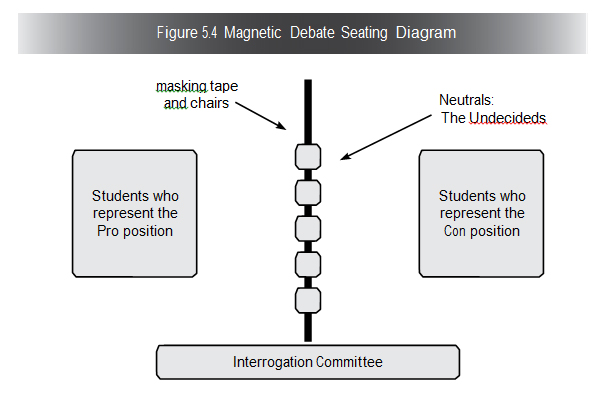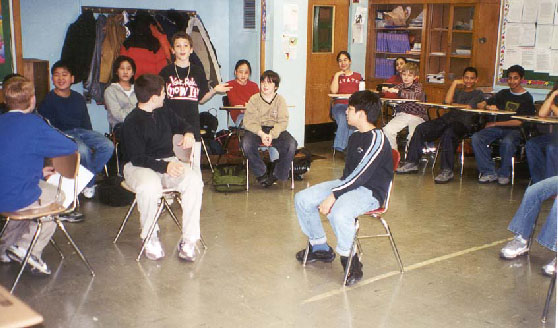The Magnetic Debate is a discussion strategy in which participants are given an opportunity to influence others through persuasive speeches, sincere advice, and education so an informed decision can be made on a controversial issue. Teachers become coaches as they encourage students to take ownership of their own learning and make it come alive. The teacher may make the selection of the area of study or have the students select it. Yet, students will ultimately research the specific topic. Then, positions are assigned “for” or “against,” with a portion of the class as “fence-sitters,” or “undecided” element, who can be swayed one way or the other. Then, the students debate the issue.
More than any other strategy, the Magnetic Debate places students in the position of working on their abilities to persuade audiences. Students must combine top-notch research with finessed speaking skills so that others will want to side with their views. This strategy gives students practice by empathizing with others as they prepare these types of speeches. It forces the students preparing and practicing the speeches to think like others would think so that they can become effective communicators. It also gives the students who are making the decisions during the debate opportunities to practice critical thinking. These students must analyze the facts and nuances set before them, so they can make informed decisions.
How to Do It
To begin, decide on a controversial issue to be discussed. The controversy should be broken down into subcategories that can be argued. For example, if discussing the differences between political parties, subcategories would include women’s rights, health care, etc. Distribute handouts to engage the students about the controversial issue, giving them some background information. These handouts place students as active participants in the controversy. The handouts are student-friendly, covering the different positions, so students will be able to research the necessary facts as an extension to the handouts. If desired, the handouts can serve this purpose, too.
So that all students will be engaged in preparing and working towards the debate, divide the class into two groups. One half will prepare for the Pro-position and the other half will prepare for the Con-position. Within both of those positions, assign the subcategories of the topic so that all students spend time doing valuable research on the correct topics. As another example, if discussing the differences between the North and South during the Civil War, subcategories would include slaves, the strength of the federal government versus state rights, etc.
Students should be partnered for the research. Have students on both sides of the issue cover each topic because each topic is subject to a rebuttal and followed by a persuasive speech from the opposing side.
Once students have had enough time to research adequately, have them write their rough drafts for the one- or two-minute speeches and allow student peers to edit the speeches for clarity. Allow students to use note cards with key phrases to prompt their speeches and encourage them to use visuals like graphs, video clips, pictures, and other things during the debate. These special visuals will help them make their points to the persuasive audience.
Preparation
On the day of the debate, select an odd number of students (3, 5, or 7) from both sides to suddenly serve as “undecideds.” Tell them to forget all the things they have learned during their research thus far. These students will not give their speeches, but rather serve as decision-makers for the debate. Their partners will take over the speeches for the activity. These “undecideds” should clear their minds of all opinions on the topic. Have students take notes or fill out graphic organizers during the debate to keep them engaged and actively learning. Also assign 3-5 students to serve on an interrogation committee, which asks questions for clarity after each speech.

To prepare the classroom, use masking tape to make a line on the floor down the center of the classroom. Students who speak for the Pro side will sit on one side of the classroom and students who speak for the Con side will sit on the other side of the classroom. The “undecideds” will place their chairs directly over the line of tape and sit down. The interrogation committee sits at the head of the classroom.
The Simulation
Set the stage by calling all participants involved in the simulation to order and then state that a decision has to be made to determine a solution to their controversial issue. Call out the first category and begin with the Pro point of view. The person who is responsible for this item stands up and addresses the interrogation committee and the “undecideds.” After the speech, allow the interrogation committee to ask one or two questions. Next, instruct the person responsible for this category from the Con perspective to give a short rebuttal to what has been said. After the speech, allow the interrogation committee to ask one or two follow-up questions.
After the category is completed (or some other small amount), allow the “undecideds” to move their chairs about one or two feet closer to the group that has persuaded them more effectively. As the sides continue to debate, you may see the chair move in one direction for part of the simulation and then back in the other direction during the latter part of the presentations. Instruct all students to write notes in their graphic organizers. Call the next category, but let the Con point of view begin, followed by the Pro point of view. Alternate switching sides for each turn.
After all categories have been heard, the side to which the largest number of “undecideds” has moved their chairs wins the debate. Once the activity has been described in detail to the students, this would be a good time to implement negotiable contracting of assessments. Samples criteria may include, the ability to listen and respond to one another, eye contact, using specific examples from a primary source document, etc.
Ideas for Assessment
Once the debate ends, have students reflect on it and the arguments they witnessed. This can be done in a class discussion, ticket-out-the-door, or a small group discussion. The information you glean from students will tell you what they learned about the topic and the activity.
Applying the Strategy
Magnetic Debates can work well in a content area where a given topic has two overarching viewpoints. Social issues tend to work best, and they cover so many content areas. For example, social issues concerning science include organ donation, animal rights, and environmental protection. Social issues in social studies include child labor or sweatshops, famine, human rights, and welfare. Language arts topics can include library censorship or a debate about characters (i.e., Was the wolf really the bad guy in The Three Little Pigs). Many of these topics can be chosen that are school-based. For example, have students debate the health of school lunches, getting a classroom pet, haircuts and hair color permitted for school, school uniforms, homework, and the classroom movie to be watched during a party.
from (c) 2014 Active Learning Across the Content Areas (Conklin & Stix)
Adapted from (c) 2002 Social Studies Strategies for Active Learners, Stix, Andi and Hrbek, Frank





